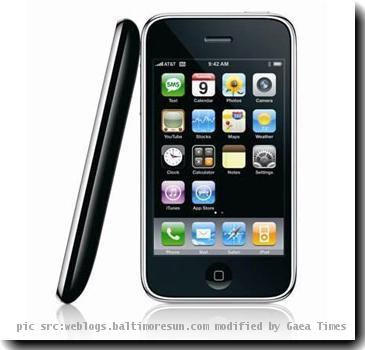AT&T 2nd-Qtr profit climbs, beats estimates, boosts outlook; iPhone activations hit record
By Peter Svensson, APThursday, July 22, 2010
AT&T 2Q earnings up 26 percent, raises forecast
NEW YORK — AT&T Inc. said Thursday that its earnings rose 26 percent in the latest quarter and raised its forecast for the year, helped by its iPhone-fueled wireless arm and cost-cutting.
The country’s largest telecommunications provider said it now expects a “strong” increase in earnings over last year, compared to its previous forecast of “stable-to-improved” results.
The company, based in Dallas, also posted its first-ever decline in wired broadband subscribers, capping a decade of growth.
Its shares rose 77 cents, or 3.1 percent, to $25.69 in midday trading.
AT&T said its net income rose to $4.02 billion, or 68 cents per share, in the April-June period, from $3.2 billion, or 54 cents a share, a year ago.
Excluding a gain from the sale of stock in an overseas firm, earnings would have been 61 cents per share, still beating the average forecast of 57 cents per share by analysts surveyed by Thomson Reuters.
Revenue was $30.8 billion, compared with $30.7 billion a year ago and slightly below analyst expectations at $30.9 billion. However, AT&T is no longer including e-business subsidiary Sterling Commerce in its results, which analysts have not taken into account. The unit is being sold.
The company signed up a net 496,000 new wireless contract customers, down slightly from the 512,000 it signed in the first quarter. That’s about half of what it has signed up in recent years, but it will still likely prove a strong result compared to the rest of the industry, where contract signups have collapsed this year.
AT&T is helped by the iPhone, for which it is the exclusive U.S. carrier. AT&T said it once again activated a record number of iPhones: 3.2 million. That was boosted by the launch of the iPhone 4 in the last few days of the quarter.
Contract-signing customers are the most lucrative, but AT&T also added a net 300,000 no-contract, prepaying customers, more than it has in any quarter since 2007. That’s thanks to another Apple Inc. product, the iPad. AT&T is the exclusive U.S. provider for the tablet computer, which launched in the quarter. CFO Rick Lindner said AT&T had activated 400,000 to 500,000 iPad 3Gs in the first two months. (A cheaper version of the tablet lacks cellular broadband capability, using only Wi-Fi for Internet access.)
With signups of new phone subscribers slowing to a crawl in the industry, AT&T and other carriers are banking on keeping growth going by providing wireless services to non-phone devices, like the Kindle e-reader. AT&T said it added 896,000 such devices, less than the 1.05 million it added in the first quarter.
Wireless service revenue grew 10 percent from a year ago, as average monthly fees rose 3.4 percent, bucking the industry trend. Data plans for iPhones and other smart phones help AT&T offset declining prices for voice calls.
AT&T keeps laying off workers, mainly from the dwindling wireline business. It has cut more than 10,000 jobs this year, ending the quarter with 272,450 employees.
The layoffs helped AT&T cut costs faster than the 3.7 percent year-over-year revenue decline in wireline, letting it post a tiny increase in operating income for the segment. The revenue decline was the smallest since the first quarter of 2008.
AT&T stemmed revenue declines despite losing 92,000 wired broadband connections during the quarter, to end at 16 million. The decline reflects cut-throat competition from cable companies and saturation of the market, at least where broadband is available. The FCC reported recently that 14 million to 24 million people in rural America still can’t get broadband.
Lindner said much of the decline was due to poaching by cable companies where AT&T hasn’t upgraded its network to so-called “U-Verse” capability, which offers higher speeds. He said the company is embarking on a project to increase Internet speeds where it doesn’t offer U-Verse.
In another sign of changing times when it comes to Internet access, the number of cellular broadband card subscriptions was flat with the prior quarter after years of growth. That was due both due to the weak economy — most of the cards are used for business — and to the fact that many people now use their smart phones instead, said Brooks McCorcle, AT&T’s senior vice president of investor relations.
AT&T is the first major telecommunications company to report for the quarter. Verizon Communications Inc., the second largest, reports early Friday.
Tags: Computing And Information Technology, Internet Technology, New York, North America, United States

